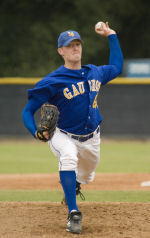
Welcome to the annual installment of Batter's Box's Top 30 Blue Jay prospects.
2009 was a mixed year for the farm system. The system as a whole had a losing record and was one of the worst farm systems in baseball in terms of wins. The winning was not helped by the Jays being unable to sign any of their top six picks in time for the Auburn season. The Jays did send a lot of pitchers to the Blue Jays this season and there are some more pitchers in the queue behind Cecil, Romero and Rzepczynski. The Jays did not have as much success with their hitters. Most of the high school hitters from the 2007 and 2008 drafts had poor seasons. College players such as JP Arencibia and Brian Jeroloman did not progress as hoped.
The Jays farm system is short on top level prospects, any of the top five prospects could be considered number one, not because there are five number ones but because there are five number fives. This system will likely be ranked in the mid-20's by Baseball America.
None of that stops us ranking the top 30 prospects so here we go, comments are welcome.
30. Chuck Huggins, LHP
Born May 6, 1986. Selected in the 23rd round of the 2008 draft.
| Year | Age | Level | G | GS | IP | H/9 | HR/9 | BB/9 | K/9 | ERA |
| 2008 |
21 |
A- |
19 |
0 |
29.1 |
5.83 |
1.23 |
3.07 |
15.04 |
2.15 |
| 2009 |
22 |
A |
7 |
7 |
34.3 |
6.29 |
0.26 |
2.88 |
10.49 |
1.57 |
| 2009 |
22 |
A+ |
18 |
17 |
99.2 |
8.13 |
1.08 |
2.71 |
7.50 |
3.25 |

Huggins is a left handed pitcher who, based on his success in 2008, was given the chance to start in 2009. He pitched well in Lansing although he averaged less than five innings per start. Once he learned to be more efficient with his pitches he was promoted to Dunedin where he again struggled initially but pitched well over his last ten starts. In those last ten starts Huggins had a 1.63 ERA, a WHIP under one and he struck out 54 in 60 innings.
Huggins features an average fastball but a good change-up and breaking ball. He also hides the ball well and he could be another Jesse Carlson if he continues to progress.
29. Jake Marisnick, OF
Born March 30, 1991. Selected in the third round of the 2009 draft.
| Year | Age | Level | AB | 2B | 3B | HR | BB | K | SB | CS | AVG | OBP | SLG |
| 2009 |
18 |
R |
0 |
0 |
0 |
0 |
0 |
0 |
0 |
0 |
--- |
--- |
--- |
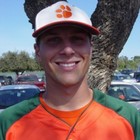
Marisnick became well known on the Internet for maintaining a Twitter account during the draft and post-draft process. He showed a lot of passion for the game as well as excitement for becoming a Toronto Blue Jay, which did not officially occur until August's deadline day for draft picks to sign pro contracts. As a result, Marisnick did not get into a pro game in 2009 after walking away from a college scholarship to play for Oregon (The school also lost No. 1 draft pick Tyler Matzek, who signed with Colorado). Marisnick will open 2010 in extended spring training and will likely be assigned to the Gulf Coast League Blue Jays in June.
Taken in the third round and signed out of a California high school for an above-slot $1 million, Marisnick has some exciting raw tools, but there are questions about his hit tool, and whether or not he'll be able to drive the ball with authority and on a consistent basis. He was considered by some to be among the Top 10 athletes in the entire draft class. Defensively, he can play center field but he's expected to move to a corner slot as he fills out. He has a strong arm, so he could certainly handle right field. The teenager still has plenty of time to quiet his doubters, but it will be a slow process.
28. Trystan Magnuson, RHP
Born June 6, 1986. Selected in the supplemental first round (56th overall) in 2007 amateur draft.
| Year | Age | Level | G | GS | IP | H/9 | HR/9 | BB/9 | K/9 | ERA |
| 2008 |
23 |
A |
24 |
24 |
81.2 |
10.03 |
0.66 |
3.86 |
5.40 |
5.40 |
| 2009 |
24 |
A+ |
38 |
0 |
61.2 |
8.17 |
0.29 |
3.94 |
6.57 |
2.77 |
| 2009 |
24 |
AA |
5 |
0 |
10.0 |
3.60 |
0.00 |
0.90 |
6.30 |
0.00 |
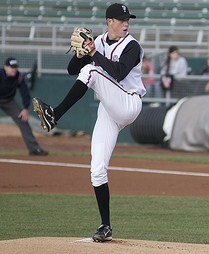
Trystan Magnuson wasn’t a heralded selection when he was taken in the first-round of the 2007 draft. A college senior, he was viewed as more of a signability pick given that Toronto had already selected four players in the first round. After a year in Lansing’s rotation in 2008, Magnuson returned to a familiar relief role in 2009 and had a better season.
He increased his strikeout rate without increasing his walks and he also cut down on both his hit and homerun ratio. His home run rate fell because he cut down his fly ball percentage from 39.7% to 32.9% and also gave up homers half as often on fly balls. While working as a starter last year Magnuson was trying to learn an effective change-up to compliment his fastball and slider. He made a bit of progress, but has likely gone back to relying heavily on the low 90’s fastball and slider. While he did keep his walk rate steady, his control is something that Magnuson needs to improve as he’s not an overpowering reliever.
The tall right-hander had a very good end of the season at the Baseball World Cup as Team Canada won the bronze in the nation’s best finish ever in the tournament, a marked improvement over their ninth place finish in 2007. Magnuson was named as the relief pitcher on the All-World team (one of only two Canadians to make the tournament’s all-star team). Detailed stats for the tournament are very difficult to find, but I don’t think Magnuson gave up a run, he picked up three wins and had several strong 2 inning outings. Next year he’ll likely return to New Hampshire and, if he pitches well, should be on track for a mid-season promotion to Triple-A and potentially a major league debut at some point in the second half of the season.
27. Reidier Gonzalez, RHP
Born November 1, 1985. Selected in the 19th round of the 2005 draft.
| Year | Age | Level | G | GS | IP | H/9 | HR/9 | BB/9 | K/9 | ERA |
| 2005 |
19 |
Rk |
7 |
6 |
27.2 |
2.93 |
0.00 |
1.95 |
7.81 |
1.63 |
| 2006 |
20 |
Rk |
13 |
13 |
61.1 |
11.01 |
0.28 |
2.35 |
7.34 |
4.11 |
| 2007 | 21 | A | 20 | 20 | 114.2 | 9.50 | 0.31 | 2.35 | 5.57 | 3.53 |
| 2008 |
22 |
A+ |
27 |
20 |
137.2 |
10.13 |
0.39 |
1.96 |
4.84 |
3.14 |
| 2009 |
23 |
AA |
17 |
17 |
93.0 |
7.94 |
0.39 |
2.42 |
6.48 |
2.90 |
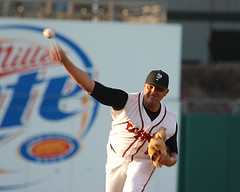
Reidier Gonzalez is a sinker/slider pitcher. Think of Jamie Vermilyea or Mike MacDonald. Those pitchers do well through AA then generally collapse in AAA. Not so fast says pitching coach Tom Signore, he believes Gonzalez's pitches move later than other similar pitchers and he feels Gonzalez has a better chance to succeed in AAA than his fellow sinkerballers. Gonzalez had a very good season in AA this year other than a groin strain that limited his playing time. Gonzalez held hitters to under 8 hits per nine innings pitched and as a sinker baller his walk and home run rates are low. On the down side his strikeout rates are also low, just 6.48 this season. That number is likely to go down as he moves up to AAA and above. Gonzalez has had inconsistent H/9 numbers and his performance likely depends a lot on the infield defense behind him.
Gonzalez is headed to the AFL and possibly AAA next year where he will need to refine his control and pitches to give him a shot at a major league career.
26. John Tolisano, 2B
Born October 7, 1988. Selected in the 2nd round of the 2007 amateur draft.
| Year | Age | Level | AB | 2B | 3B | HR | BB | K | SB | CS | AVG | OBP | SLG |
| 2007 |
18 |
R |
183 |
5 |
0 |
10 |
26 |
40 |
7 |
1 |
.246 |
.336 |
.437 |
| 2008 |
19 |
A |
432 |
20 |
8 |
6 |
56 |
110 |
5 |
2 |
.229 |
.315 |
.354 |
| 2009 |
20 |
A+ |
401 |
19 |
2 |
12 |
44 |
78 |
5 |
4 |
.232 |
.305 |
.379 |
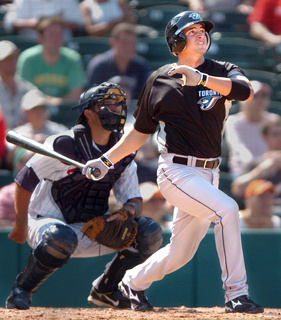
The struggles of the Jays' 2007 crop of high-round high school draft picks have been well-documented in these parts, and while Justin Jackson and Kevin Ahrens get most of the (negative) attention, it is certainly not unfair to lump John Tolisano in with them. After all, even though Tolisano was the 6th player Toronto selected in 2007, he was still a 2nd round pick, and the numbers you see above are not what us fans hope for from a 2nd round pick.
Fortunately, those numbers don't tell the whole story. While Tolisano's 2008 and 2009 lines look similar, a bunch of little differences add up to real improvement. First, John's K rate decreased this year from 25.5% to 19.5%, a significant difference. His walk rate also decreased, but only from 11.5% to 9.9%. 9.9% is a very solid walk rate for a 20 year old middle infielder at high A, so all in all plate discipline was definitely an area of improvement. Furthermore, Tolisano showed increased power this year - his ISO jumped from .125 to .147, and while that isn't a huge boost, it's impressive when considering the decrease in K rate. And lastly, Tolisano's BABIP was a dismal .260 this year, compared to .294 in 2008. As far as I know, batted ball type data isn't available for minor league players, so it's difficult to tell what his baseline is, but it's certainly worth noting that Tolisano's slash line remained almost identical to last year despite a BABIP 35 points lower.
It has been suggested in the past that Tolisano may eventually need to move to a corner outfield spot, but that hasn't happened yet, so his defense at second base must be considered at least adequate by the Jays' minor league crew. For what it's worth, his range factor improved slightly this year (4.56 to 4.86), while his fielding percentage stayed about the same (.959, 21 errors in 101 games).
Overall, Tolisano is a solid offensive player with no glaring holes (except, maybe, low batting average, but I'd like to see where his BA falls next year given his BABIP in 2009). At the same time, though, none of his offensive skills are outstanding - his K/BB ratio is good but not great, as is his power. 2009 should be considered a moderate success for Tolisano, and if he continues to trend in the right direction offensively, combined with a bounce-back BABIP, we could start to see some big numbers in a hurry.
25. Ryan Schimpf, 2B
Born April 11, 1988. Selected in 5th round of the 2009 amateur draft.
| Year | Age | Level | AB | 2B | 3B | HR | BB | K | SB | CS | AVG | OBP | SLG |
| 2008 |
20 |
NCAA |
250 |
18 |
7 |
12 |
32 |
51 |
16 |
4 |
.320 |
.416 |
.592 |
| 2009 |
21 |
NCAA |
262 |
19 |
1 |
22 |
44 |
50 |
18 |
7 |
.336 |
.449 |
.668 |
| 2009 |
21 |
A- |
129 |
7 |
1 |
3 |
15 |
24 |
4 |
1 |
.287 |
.369 |
.426 |
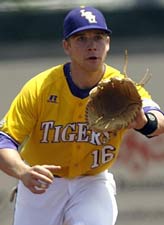
After a stellar career at LSU, the Jays made Schimpf their seventh pick of this June's draft and saw him show continued improvement throughout his stretch in Auburn. Schimpf appears to be one of those vanilla-type college infielders who possesses a solid yet unremarkable skill set. The second-baseman showed some power in the second half of his season slugging .526 over his final 19 games. His plate discipline also improved dramatically with only 2 strikeouts over his last 43 at-bats.
Despite a small sample size, Schimpf does possess some dramatic lefty-righty splits, OPSing .946 against righties while only .346 (in 33 AB) against the portsiders.
With only 133 professional at-bats, it's much too early to make any conclusions about Schimpf. That said, at 22 years of age on opening day 2010, Schimpf will likely see some time at Lansing and will hope to beat up on some younger opposition in order to start turning some heads. All in all, Schimpf seems like one of those guys who has a solid shot at reaching the majors in a utility role who can show some pop off the bench.
24. Brad Emaus, 2B
Born March 28, 1986. Selected in the 11th round of the 2007 amateur draft.
| Year | Age | Level | AB | 2B | 3B | HR | BB | K | SB | CS | AVG | OBP | SLG |
| 2007 |
21 |
A- |
136 |
6 |
0 |
2 |
12 |
26 |
2 |
0 |
.228 |
.298 |
.316 |
| 2008 |
22 |
A+ |
473 |
34 |
3 |
12 |
60 | 56 | 12 |
4 |
.302 |
.380 |
.463 |
| 2009 |
23 |
AA |
505 |
28 |
2 |
10 |
59 |
69 |
10 |
3 |
.253 |
.336 |
.376 |
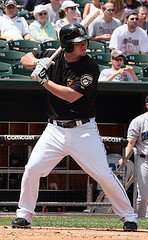
Emaus jumped into the spotlight after posting an .843 OPS in Hi-A during his first full season of pro ball. He showed excellent plate discipline walking more than he struck out and added some pop with 49 extra base hits. The Jays hoped the good times would continue to roll with Emaus and promoted him to AA New Hampshire to start the 2009 season.
On the surface, it appears as though Emaus suffered through a disappointing campaign. However, digging a little deeper shows that his season was remarkably similar to 2008. Emaus's BB and K rates stayed fairly consistent, as did his Line Drive rate, at a healthy 17%. Perhaps the main culprit here is everyone's favourite whipping stat: BABIP. Emaus saw his BABIP drop 46 points year over year from .323 in 2008 to .277 this season.
Emaus's 2009 numbers were also derailed by a truly horrific month of June in which he OPS'd .383. He finished the season with some power, though, slugging four homers in August and hitting .324 over his final ten games.
Emaus will no doubt repeat AA to start his age 24 season. He's pretty clearly blocked at the Major League level by Aaron Hill but if his numbers bounce back to 2008 levels, and he maintains his excellent plate discipline, the Jays will surely find somewhere for him to play in the bigs.
23. Bobby Ray, RHP
Born January 21, 1984. Selected in the 7th round of the 2007 amateur draft.
| Year | Age | Level | G | GS | IP | H/9 | HR/9 | BB/9 | K/9 | ERA |
| 2005 |
21 |
A- |
15 |
13 |
61.2 |
6.71 |
0.29 |
2.92 |
8.46 |
2.77 |
| 2006 |
22 |
A+ |
14 |
9 |
48.2 |
10.91 |
0.37 |
2.40 |
6.84 |
4.99 |
| 2007 |
23 |
A+ |
18 |
15 |
66.2 |
11.20 |
0.40 |
3.24 |
7.69 |
4.86 |
| 2008 |
24 |
A+ |
13 |
13 |
70.2 |
9.04 |
0.76 |
2.29 |
7.64 |
4.20 |
| 2008 |
24 |
AA |
16 |
16 |
96.1 |
10.10 |
0.56 |
2.52 |
6.73 |
3.18 |
| 2009 |
25 |
MLB |
4 |
4 |
24.1 |
8.51 |
1.49 |
2.24 |
4.88 |
4.44 |
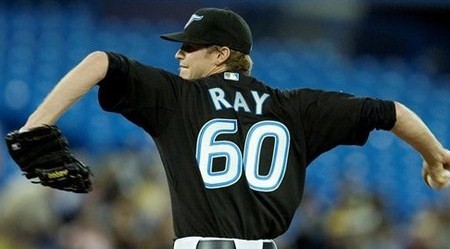
After battling injuries in 2006 and 2007, Robert Ray got back on track in 2008, and it looked like newly-christened Bobby Ray was even backer on track in 2009, with a surprisingly successful 4-start stint in the bigs. As you can see in the numbers, Ray's strikeout rate was quite low in the show, but his walk rate and hit rate were very good, so his 4.44 ERA was not undeserved. FanGraphs has his tRA at 4.92, so he was a bit lucky, but 4.92 is still quite respectable for someone with less than 100 innings above A ball.
Unfortunately, the injury bug bit again, and Ray was out for most of the rest of the year. With the depth of the Jays' starting rotation, he'll have the opportunity to work his way back slowly, but it certainly looks like Ray will carry the "injury-prone" label for a while. He is a good, possibly major league caliber pitcher when healthy, but that "when healthy" qualifier is the key.
22. AJ Jimenez, C
Born May 1/1990. Selected in the 9th round of the 2008 amateur draft.
| Year | Age | Level | AB | 2B | 3B | HR | BB | K | SB | CS | AVG | OBP | SLG |
| 2008 |
18 |
R |
47 |
2 |
0 |
0 |
3 |
16 |
5 |
2 |
.191 |
.255 |
.234 |
| 2009 |
19 |
A |
278 |
15 |
1 |
3 |
7 |
72 |
5 |
2 |
.263 |
.280 |
.356 |
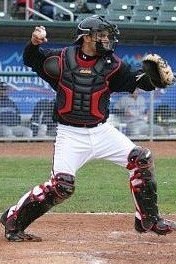
The 6-foot, 185-pound catcher drew lofty comparisons before being selected by the Blue Jays. He was regarded as the best catcher from Puerto Rico since Yadier Molina with a frame similar to Javy Lopez. An elbow injury led to his stock falling on draft day but it turned out not to be that serious as the Jays signed him to a $200,000 bonus which was the equivalent of fifth-round money. During his brief trial with the GCL club in 2008, Jays farm director Dick Scott praised Jimenez’s athleticism and strong arm as well as his ability to swing the bat. His defence is considered to be ahead of his offence but he did make gains with the bat with Lansing in 2009. He was batting below .230 at the end of May before heating up with a .333 mark in June and he followed up with a .279 July. Though his batting average fell in August, his isolated power average was .130 as he hit two of his three homers that month. However, the right-handed hitting Jimenez struck out in nearly one-quarter of his at-bats and drew only seven walks last season. Still, Jimenez can steal the odd base as he went 5-for-7 in that department for the second year in a row and he filled in at third base for a couple of games with the Lugnuts. Right now, Jimenez’s calling card is his defence as he threw out 35 percent of would-be base stealers in the Midwest League. It would appear Jimenez showed enough with Lansing to merit a promotion to Dunedin in 2010.
21. Luis Perez, LHP
Born January 20, 1985. Signed as a free agent from Dominican Republic in 2003.
| Year | Age | Level | G | GS | IP | H/9 | HR/9 | BB/9 | K/9 | ERA |
| 2007 |
22 |
A- |
16 |
16 |
75.1 |
8.7 |
0.1 |
4.5 |
8.1 |
3.70 |
| 2008 |
23 |
A |
28 |
23 |
137.1 |
8.9 |
0.3 |
3.3 |
9.0 |
3.60 |
| 2009 |
24 |
AA |
28 |
27 |
162.1 |
8.0 |
0.6 |
3.7 |
6.2 |
3.55 |

The Blue Jays challenged the Dominican lefty by skipping him past Dunedin to New Hampshire and he responded by earning an invite to the Future Stars Game to St. Louis. The 6-foot, 205 pound hurler got off to a great start by recording a 2.45 ERA in the month of April. Even though that mark soared to 4.37 in May, he bounced back with monthly ERA’s below 3.50 for June and July. However, fatigue may have set in as his ERA went back over 4.50 for August. Perez didn’t strike out nearly as many batters with New Hampshire as he retired just over 16 percent of hitters via the “K”, as compared to over 20 percent in his first two seasons in the minors. His walk rate also remains a concern as it crept up to nearly 10 percent in 2009. The BABIP gods did smile upon Perez as his mark for 2009 was .277, compared to .352 and .326 in 2007 and 2008 respectively. Still, there’s a lot to like about Perez. His infielders will always be kept on their toes as his ground ball rate was 58 percent and he allowed less than a hit an inning as opponents batted .239 against him. His two-seam fastball is said to come in at 90-91 MPH with good, downward movement according to Baseball America and he also throws a curve and a change with a funky delivery. Perez should have a chance to work on his repertoire in the state of Nevada for 2010.
Check back tomorrow for prospect numbers 20 through 11.
https://www.battersbox.ca/article.php?story=20090925104512404